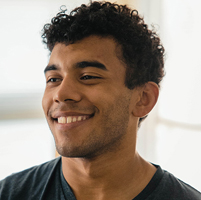A Gen Z Take On NFTs Shows News Storytelling’s Future
Many Americans struggle to wrap their heads around the concept of nonfungible tokens, or NFTs. Given the pace of technological advancement today, it’s understandable why it might take time for people to catch up.
That’s why University of North Carolina senior Christian Ocana developed a multimedia explainer about the new, hot commodity, propping up a school program in the process, and taking home first prize in this year’s Hearst Multimedia Innovative Storytelling Competition.

Christian Ocana
Along with completing coursework toward his undergraduate degree in journalism, with a focus on visual communications, the 22-year-old Ocana is an innovation fellow at the Reece Innovation Lab. Operating under the umbrella of UNC’s Hussman School of Journalism and Media, the lab is a team of developers, educators and students that partners with various organizations, including media companies, to help them better understand and use cutting-edge tools in their storytelling pursuits.
As an innovation fellow it’s Ocana’s job to effectively communicate the lab’s mission and work, as well as the advantages of adopting technologies the group engages with — virtual and augmented reality, artificial intelligence and the metaverse. The lab’s chief innovation officer, Steven King, assigned Ocana the NFT explainer story, and was so impressed with what Ocana produced that he suggested its entry into the Hearst Competition to a school adviser.
“I guess it did well!” Ocana says, expressing disbelief over its top-prize finish, for which he received a $3,000 scholarship.
Humility aside, what Ocana pulled off might provide a glimpse into a not-too-distant future for MMJ story design.
Entries into this leg of the Hearst competition, according to the organization, must “demonstrate original and innovative ways to tell stories and engage with audiences using immersive digital tools and techniques.” Virtual, augmented and mixed reality, as well as 360-degree video — or what Hearst calls “emerging media” — must also be employed, as well as graphics, data visualization, animation, video, photos and social media.
Ocana’s piece, Nuanced or Just Neat? Here Is What’s So Nifty About NFTs, is a combination of feature-length-by-internet-standards text, social media embeds, illustrations, graphs and photos. There’s also not one but two long-by-TV-news-standards videos of four and five minutes each, including a Zoom interview with an expert source he connected with on Twitter, as well as a documentary starring Ocana.
“This [documentary] video was a lot of weeks and months of me working through a really goofy script and then sending it in for feedback and looking up other videos on how to put in as much information as possible into five minutes,” Ocana says. For structural inspiration, he turned to Vox producer Johnny Harris’s portfolio.
Besides having a friend around his shoots “in case anything burned down,” Ocana says he filmed himself and additional footage — including a humorous segment outlining how any ubiquitous item, such as an egg, can have a unique, intrinsic value attached to it that’s nonfungible — on a Sony Alpha 7 III camera he recently purchased himself. Adobe Premiere was used in the editing phase; Adobe Illustrator helped him with some graphics that appeared in the video, too. He also generated a timeline of NFT history using the open-sourced Canva graphic design platform.
Ocana then presented his piece to his Reece Innovation Lab teammates who adopted avatar representatives of themselves —robots, foxes and deep-sea divers — in a metaverse screening room.

Meredith Hogan
Meredith Hogan, one of three judges for this year’s Hearst Multimedia Competition, who formerly ran special multimedia projects for NBCNews.com and is currently senior creative producer at Red Element Studios in Seattle, says Ocana did “a great job of making a complex idea approachable” throughout his multifaceted piece. “He does this not only through his thorough and clear reporting about the ins and outs of the concept and application of NFTs, but also through the friendly, and gently ironic tone of his first-person video storytelling,” she continues. “This is not your Grandma’s news, but rather, reporting tailor-made for Gen Z.”
Hogan is hardly the only figure in the news industry who’s embracing this versatile style of storytelling, knee-deep in new tools. In spite of their reputation as tech-averse dinosaurs, King, the Reece Lab’s chief innovation officer, says the news group leaders he deals with are far more open-minded about these developments than most might assume.

Steven King
“They totally see this as ‘business changes,’ ‘things are different,’” King says. “They’ve been in business for the last 20 years trying to make decisions in a tumultuous world…. What they know how to do is assess a situation.”
For Ocana, if other news execs, producers or MMJs come across his work and find inspiration in it, that would be the highest compliment.
“I hope somebody looks at this project and goes, ‘Oh, I can do a better job than that,’ and then they do,” he says. “In a perfect world, I want work like this to be super-accessible to everybody.”
Editor’s Note: This is the latest of TVNewsCheck’s “Newsroom Innovators” profiles, a series showcasing people and news organizations evolving the shape and substance of video reporting. These profiles examine the inception of their innovations, the tools they employ and how they’re reconciling experimental approaches to news storytelling within daily workflows. You can find the others here.
























Comments (0)